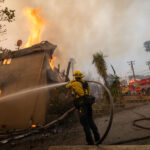If it seems like you’re seeing more drivers with phones stuck to their ears, it isn’t your imagination. There are more than 88 million cell phone users in this country —40,000 new subscribers every day—and many of them are using those cell phones behind the wheel. According to a 2001 report by the National Highway Traffic Administration, at any given time 3 percent of U.S. motorists, or about 500,000 drivers, are using hand-held cell phones while driving. Cell phone use increases by almost 100 percent during rush hour—one of the most dangerous times to be distracted.
For American businesses—including insurance companies and agents—the cell phone has proven to be an invaluable communication tool that can improve efficiency and expedite customer service. But for some employers, this convenience is coming at a very steep price as collisions involving employees using their cell phones expose businesses to negligence lawsuits. And it’s an exposure that insurance agents and insurance companies share with their commercial auto customers.
Just this past December, a Florida jury awarded $20.9 million to a 79-year-old woman for severe injuries she suffered when a salesman talking on a cell phone broadsided the car in which she was a passenger. The cell phone company records showed that the salesman was engaged in a business cell phone call just 46 seconds before he called 911 to report the accident. That was enough for the jury, which ruled that both the driver and his employer were responsible.
In a similar case, Salomon Smith Barney recently settled a 1997 lawsuit for $500,000 after one of its brokers ran a red light and killed a motorcyclist while trying to retrieve a dropped cell phone. Other cases are showing up and the claims are getting bigger. One wrongful death suit in California seeks $30 million from a lawyer and her employer, alleging that the lawyer was engaged in a business call at the time of the accident.
Cell phone use is certainly not the only distraction that drivers face; in fact, polls and research show that it is not even the most commonly cited distraction as a cause of accidents. Drivers reading newspapers, books or maps behind the wheel, or putting on makeup are at least as likely to cause a collision.
But the trendiness and growing use of cell phones—or to be more precise, telephone conversations while driving—is proving to be the perfect target for trial lawyers intent on cultivating negligence lawsuits. And the proliferation of in-vehicle communications devices for e-mail, Internet use and electronic navigation will only exacerbate the problem.
More and more research indicates the major distraction is not the act of dialing or holding a phone but the cell phone conversation itself. Preliminary results from a recent University of Utah study indicate that drivers talking on a cell phone missed twice as many simulated traffic signals as when they weren’t on the phone, whether the phone was hand-held or hands-free.
And while 56 percent of respondents to a recent Gallup poll said using a cell phone while driving was “very dangerous,” most users don’t seem to be disconnecting just because they’re behind the wheel. In response, some states and municipalities are taking action against in-traffic use of cell phones. The state of New York and some municipalities have enacted partial cell phone restrictions. Twenty-seven states considered cell phone restrictions in 2001. It’s likely that many more will do so again this year, and a number are likely to pass them.
Whether or not such laws are appropriate or effective is a matter for local lawmakers to decide. But American businesses must recognize that these laws and continuing media attention on cell phones will increase employer vulnerability when employee accidents involve cell phone use.
As these cases become more common, the key factors will be whether or not the employee was driving or talking on company business, driving a company vehicle, or using a company-supplied cell phone or other distracting device at the time of the accident.
Employers must take steps to minimize all controllable distractions for employees who drive on business. It is something that underwriters will increasingly expect in well-managed accounts.
Insurance agents and companies can set an example for their customers by implementing effective policies and controls on employee cell phone use while driving. We should know better than anyone else how to minimize loss exposure in ways that make good business sense. It is easier to sell a customer on a loss prevention activity when you can say, “We do it ourselves.”
No employee should have to live with the knowledge that he or she hurt, or even killed someone because a business call could not wait until the car was stopped. An insurance agency or company whose employee causes an accident while using a cell phone (or any other high-tech distraction) will get even less sympathy from a jury than other businesses.
For many reasons, adopting a comprehensive safety policy for cell phone use is the right thing to do.
Dave Golden is director of commercial lines at the National Association of Independent Insurers. Prior to joining NAII, he had extensive experience in insurance company underwriting, marketing and management.
Was this article valuable?
Here are more articles you may enjoy.


 Catastrophe Bonds Linked to Wildfires Lose ‘Untouchable’ Status
Catastrophe Bonds Linked to Wildfires Lose ‘Untouchable’ Status  ‘Door Knocker’ Roofers Were Everywhere. NC Farm Bureau Saw an Opportunity
‘Door Knocker’ Roofers Were Everywhere. NC Farm Bureau Saw an Opportunity  Son of Ponzi-Accused Georgia Building & Loan Founder Now an Insurance Agent
Son of Ponzi-Accused Georgia Building & Loan Founder Now an Insurance Agent  North Carolina Sting Operation Alleges Roofer Damaged Shingles to File Claim
North Carolina Sting Operation Alleges Roofer Damaged Shingles to File Claim 


